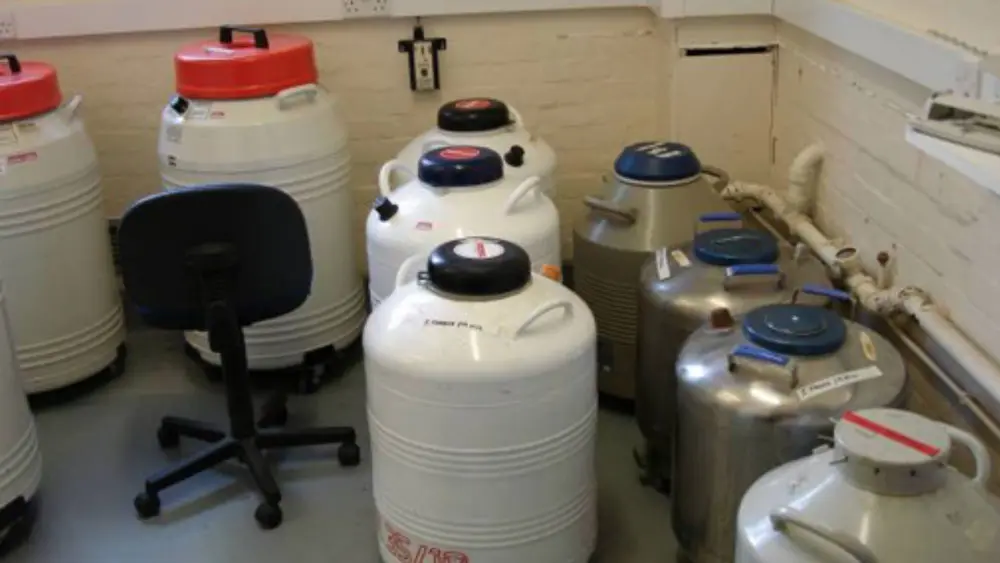Is it time to upgrade from aluminium storage container freezers to a larger automated freezer?

Recognise this? It’s a common sight in many research facilities across the world: container after container filled with important biological samples. It may mean it’s time to upgrade from containers to a better, long-term solution.
Often, research projects or sample storage facilities will start small, using just one or two containers - often referred to as ‘dewars’ - to store a few samples. As the facility grows, more and more containers are added until you have a makeshift cryo-room which probably looks something like the above image.
Samples are generally never thrown away by researchers or laboratory staff. This means your collection of containers could keep growing exponentially, taking up more and more space as time goes on.
Dewar or not?
‘Dewar’ is a commonly accepted term for this type of aluminium container though this is a bit of a misnomer.
The dewar, or ‘vacuum flask’, was invented in 1892 by Scottish inventor James Dewar. This was a basic double-walled glass flask with the air removed from the space between the two walls. This prevented the interior of the flask and whatever was stored inside from warming as there were no air molecules for the heat to pass through.
People might use the term ‘dewar’ to refer to sample storage containers or the containers which are used to store samples in nitrogen vapour for transportation. However, in the technical sense ‘dewar’ refers only to containers with a capacity of up to 50L. Both products are a far cry from James Dewar’s original creation, though they still make use of the vacuum design.
Aluminium sample containers, also known as ’cryogenic freezers’ are different as they are designed with sample storage in mind. Samples are kept in racks and suspended in liquid nitrogen within the dewar. The temperature sits far below the glass transition point of water (-135°C) where almost all biological functions cease.
The problem with aluminium containers
For some, the cost benefits of aluminium containers often outweigh the issues caused by these storeroom space hogs. However, the issue with cryogenic dewars or containers goes far beyond the space they take up in your facility as in some cases they can even pose a safety risk to researchers.
Due to the tendency of cryogens to rapidly expand when warmed, uncontrolled release of cryogens - such as during refilling - can displace oxygen in the air. This can lead to oxygen deficiency and possible asphyxiation. And when it comes to sample safety, aluminium containers don’t come with the same safety features as more advanced storage solutions.
Cryogenic dewars can also be unreliable when used for long periods of time. Though storage containers might come with temperature monitors, some don’t and require the use of an external monitor to check temperature. If a temperature monitor isn’t used, it would mean in the case of sudden increase in temperature you may not be aware of it until it is too late. For the most effective early warning system, all monitors should be connected to the Building Management System (BMS) whether you have a wired or wireless system, the complexities of this will increase with the number of dewars that you have.
You should also consider the footprint of storing in multiple aluminium freezers, even some of the largest automated stainless steel freezers occupy little more floor space than four aluminium freezers, but by comparison can offer almost four times the storage capacity.
When storing vital, irreplaceable samples, using an aluminium container as a long-term solution is far from the ideal solution.
The next step
So, has your need for sample storage outgrown your capacity for storage containers? Or perhaps the value of your samples means you can no longer rely on a basic solution?
The next logical step up for most research and sample storage facilities is investing in a full-size, automated cryogenic freezer. Though these sacrifice the portability benefits of aluminium containers the sample security advantages they offer are unrivalled.
Generally available with liquid or vapour phase storage, LN2 storage freezers such as the HEco are installed in your facility and plumbed into an LN2 supply tank outside. The LN2 is efficiently carried via a Super Insulated Vacuum Line (SIVL) into the building. External bulk storage tanks are simply filled by a professional supplier, minimising the risks associated with manual handling of liquid nitrogen for your staff.
The main benefit of liquid nitrogen freezers, however, is the long-term storage capability. With a continuous supply of LN2 a freezer such as the HEco could theoretically keep samples frozen and protected indefinitely.
LN2 freezers also feature temperature monitors and alarms to prevent failure and loss of samples. The slow burn-off rate of liquid nitrogen also means that in the event of a supply failure samples will remain viable for several weeks, assuming the freezer remains closed during this time.
Some researchers may prefer to go down the upright mechanical ‘ultra-low’ freezer route. However these units typically operate at -80°C meaning they are not suitable for long-term cryogenic storage of samples. While it’s true that some mechanical freezers are now available that will operate down to -150°C, for truly reliable cryogenic storage (below 135°C), the most trusted option is a liquid nitrogen freezer.
Whilst dewars or cryogenic containers are a cost-effective option for many facilities when starting out there will come a time when upgrading becomes necessary. Even if you still have plenty of room, it may be better to upgrade sooner rather than later. Fully automated stainless steel liquid nitrogen freezers are a secure, long-term option for cryogenic storage bringing with them a host of benefits.
To find out more about our range of cryogenic freezers, get in touch on 0800 389 0202 or apukinfo@airproducts.com.
Arrange to speak to
an expert
Complete the form below and one of our experts will be in touch.
Download our
brochure

